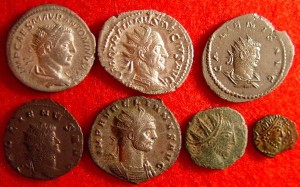Mad Coin-Burying Halliday July 4, 2010
Author: Beach Combing | in : Ancient, Modern , trackback
Beachcombing has noted, over the years, with great and punctilious interest, objects and people that archaeologists and historians have found in places where they almost certainly should not have been. Buddha statues in Viking Denmark, Viking weapons in pre Colonial Minnesota, American Indians in Europe… Some of these may be genuine traces of past contact between widely separated regions. However, others are misunderstandings or the result of deliberate fraud. And why would anyone ever mislead future generations in this way? Read on, dear reader, and prepare to be appalled.
In Charles Harper, The North Devon Coast (1908), p. 41-2, there appears the following passage.
This is the entrance to the Glenthorne grounds, which are not so strictly private as the stranger might suppose. Through the gateway, the path continues, bordered here with laurels and fir-trees, and so dips down toward the mansion, built in 1830, in the domestic Gothic style, on a partly natural terrace, three parts of the way down the wooded cliffs and hillsides that go soaring up to a height of five hundred feet. The house is situated exactly on the borderline of Devon and Somerset [UK], and is in the loneliest situation imaginable; having, indeed, been in the old days a favourite spot with the smugglers of these coasts. It was built, and the grounds enclosed, by the Reverend W. S. Halliday, a person whose eccentricities may yet be heard of at Lynmouth. One of his peculiar amusements was the sardonic fancy for burying genuine Roman coins in places where it is thought no Romans ever penetrated, with the expressed idea of puzzling future antiquaries. It seems – since he cannot be there to chuckle over the jest – a strange kind of humour.
Beachcombing wrote, when he first read this several years ago, the Reverend’s name on a virgin white filing envelope, expecting to stumble on a wealth of references: here after all was a colourful delinquent, the kind that attracts interest. But Beachcombing has found surprisingly little. Harper, for instance, speculates, p. 43, on seeing ‘the prehistoric camp of Old Barrow, perched on a steep height’, that ‘I daresay a good many of the sardonic Mr. Halliday’s Roman coins are buried in Old Barrow, waiting antiquarian discovery.’ That should be enough to chill the blood of anyone interested in the past, but does not really tell us anything new.
So what is known? Well, Walter Stevenson Halliday (obit 1872) built Glenthorne House c. 1830 as the passage above suggests. And his ghost, allegedly, haunts that house to this day: probably historically-minded angels blocked the Reverend’s way through the pearly gates… Indeed, Sir Christopher Ondaatje, the present resident, begins a recent book The Glenthorne Cat with an (imaginary?) conversation between the author and the ghost of Halliday.
Can any reader pass on any other information about Halliday? More particularly can they tell him where, indicatively Halliday buried his coins? In the passage above it sounds almost as if he did so while abroad on holiday: ‘in places where it is thought no Romans ever penetrated’? drbeachcombingATyahooDOTcom



